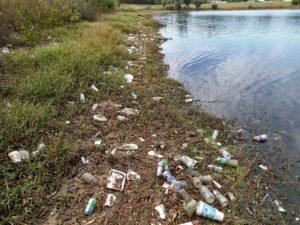The statistics are everywhere:
- Three times the size of France
- Twice the size of Texas
- 1.8 trillion pieces of plastic weighing 80,000 metric tons
These jaw dropping statistics were brought to light in a recent scientific study. The enormous mass known as the Great Pacific Garbage Patch continues to grow at an alarming rate. According to the three year study published in March, this trash island is about 1.6 million square kilometers in size. That’s up to 16 times bigger than previous estimates!
Laurent Lebreton, is the lead author of the study and an oceanographer with the Ocean Cleanup Foundation (a nonprofit developing systems to remove ocean trash). In the summer of 2015, he and his colleagues analyzed samplings of the actual trash that makes up the garbage patch. They found everything from glass, rubber, plastic, and wood. They also recovered a startlingly number of plastic fishing nets. These nets, designed to withstand being submerged in sea water, made up almost half of the total weight of the debris they collected. While plastics in general made up 99.9% of all the trash collected.
When we are faced with such a large and growing problem, what can we do as individuals? It seems like an overwhelming task. The fishing nets are an industry issue that will need to be addressed on the corporate level, but there is a tremendous amount of the trash being caught in those nets that is the result of individuals.
One important fact that has been brought to light with all the studies of our trash islands is that just because we throw something away today doesn’t mean that it is gone. Trash stays with us. The National Resources Protective Association published the following decomposition rates to provide a timeline of how long our trash stays with us.
Decomposition Rates for Common Types of Marine Debris
- Paper towel 2-4 weeks*
- Orange or banana peel
- 2-5 weeks
- Newspaper 6 weeks
- Fabric 1-5 months
- Apple core 2 months*
- Cardboard box 2 months
- Wax carton 3 months*
- Plywood 1- 3 years
- Cigarette butt 1-5 years
- Wool socks 1-5 years
- Plastic bag 10-20 years
- Styrofoam 50 years*
- Aluminum can 80-200 years
- Plastic 6 pack ring 400 years
- Disposable diaper 450 years
- Glass bottle 1 million years
- * Indicates decomposition in saltwater. Freshwater degradation would take longer.

So much has been written and broadcast about the plight of our oceans and these islands created from trash. What about the freshwater lakes and rivers closer to home?
In the past year Aquascape Environmental has removed 18 dump truck loads of trash from area lakes and ponds. Of that amount, we were able to divert 12 dump truck loads of recyclable materials from entering our landfills. Each year the amount of trash that we remove from area lakes continues to rise. This is a local problem and we all need to do our part to dispose of trash properly.
Simple things we can do to lessen the amount of thrash that ends up in our waterways:
- Put trash in a garbage can
- Sort and recycle items that can be reused or repurposed
- Drink water from reusable bottles
- Put cigarette butts in an ashtray
- Reuse items such as shopping bags
These are things that we can do every day. But they require an attitude shift in how we live our lives. When we choose to reuse, repurpose, and recycle there seems to be an added benefit. According to the website, The Happiness Wagon, eco-friendly behaviors are linked to happiness and satisfaction in life. It has been shown that people who adopt behaviors that promote environmental conservation are much more likely to report higher levels of satisfaction with life and an increased sense of community. We all need to be better stewards of our Planet. And as Pogo said “We have met the enemy and he is US!” so be mindful of that and how you take care of this planet.


